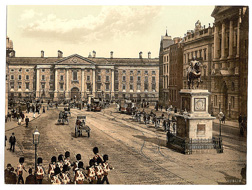
It’s June 16 – Bloomsday to admirers of James Joyce and his novel Ulysses, which recounts one day (June 16, 1904 in Dublin) in the life of protagonist Leopold Bloom.
I am also reminded today of Joyce’s novella “The Dead,” where main character Gabriel Conroy recalls the time his grandfather, Patrick Morkan, donned top hat and collar, and hitched his horse Johnny to the family trap to attend a military review “with the quality” in Dublin’s College Green.
Johnny’s regular job was to power the mill in Morkan’s starch factory and the horse remembered his station as he trotted into College Green.
Conroy evokes laughter from party guests as he relates the incident:
“And everything went on beautifully until Johnny came in sight of King Billy’s statue; and whether he fell in love with the horse King Billy sits on or whether he thought he was back again in the mill, anyway he began to walk around the statue…
“Round and round he went…and the old gentleman, who was a very pompous old gentleman, was highly indignant. Go on, sir! What do you mean, sir? Johnny! Johnny! Most extraordinary conduct! Can’t understand the horse!”
The statue of “King Billy” was erected by the citizens of Dublin to commemorate the victory of Protestant William the Orange over King James II at the Battle of Boyne in 1690. This did not sit well with Irish Catholics, and from the time it was erected in 1701, until it was dynamited in 1929, the statue of William III became a target for political dissidents.
To a horse owner, Johnny’s behavior is almost predictable. But the incident is symbolic for Joyce, an expatriate Irishman, who identified rote-conditioned Johnny and his aspiring owner with the Irish people and the Irish leadership of that time.
Happy Bloomsday!
